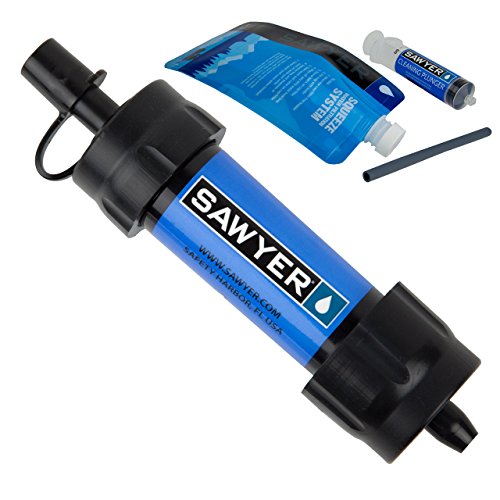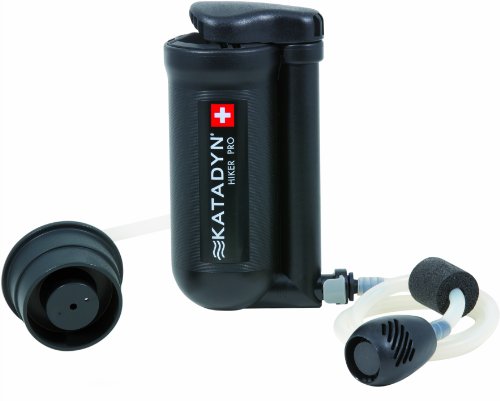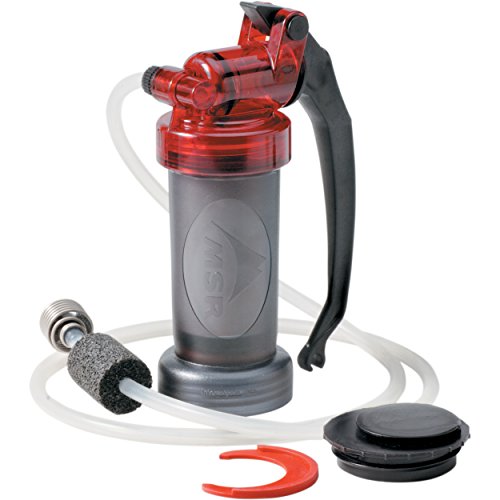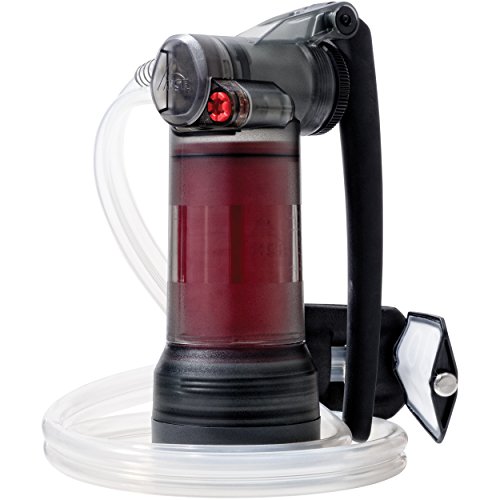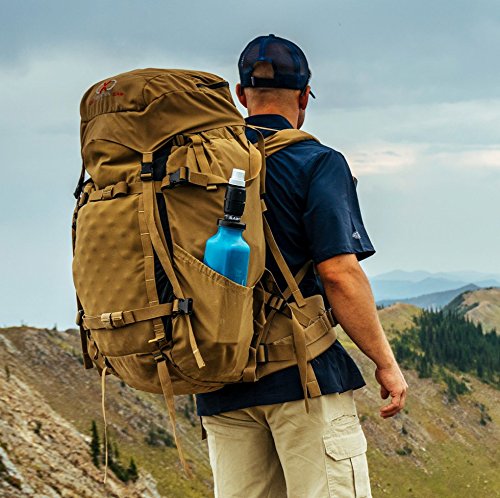
Backpacking water purification is a hotly contested area.
Water filters are hailed by many as the only way to purify properly. Of course, there are many other types of water purification available to modern hikers, but the filter seems to reign king among them.
Why? Filters are easy to use.
They’re popular and remain trusted.
They’re effective at both filtration and purification.
In today’s backpacking water filter reviews we’ll examine the pros and cons of many filters you can choose from. I’ll help you sort out fact from fiction to find the best backpacking water filter to suit your needs. My goal is to get you on the trail with the knowledge and information you need to be successful and safe!
Comparison Table
Name | Price | Weight | Rating | Notes |
|---|---|---|---|---|
$$$ | 2 oz | Screw onto most disposable water bottles | ||
$$$ | 1.2 lbs | Activated carbon in the core improves the taste and reduces chemicals in drinking water | ||
$$$ | 1 lb | Can be cleaned repeatedly for full filter recovery with no tools required | ||
$$$ | 1 lb | Winner of both Backpacker Magazine's 2016 Editors' Choice Award and Outside Magazine's 2016 Gear of the Show Award | ||
$$$ | 10 oz | Hollow-fiber membrane micro-squeeze filter is rated up to 100,000 gallons |
How to Choose the Best Backpacking Water Filter
Filtration vs Purification
There’s a legitimate difference between filtration and purification. Keep in mind that these semantics actually matter quite a bit in many cases.
Filtration
describes removing suspended sediment from water. This can be done with a cloth, bandana, water filter, or other means.
Purification
describes removing pathogenic contents from the water. This can be done with purification chemicals, mechanical filters, UV light, or a few other methods.
In some cases, you may only need purification. Locations along the AT, in many cases, already have clear water. This water only need purification to be safe to drink!
Other cases, you need mechanical filtration before or along with purification. This can be done with a water filter in a single stage. You could also choose to strain out particularly nasty water through a cloth or bandana and then treat it chemically, with UV, or mechanically.
Do You Have to Purify Water?
On the trail, you may run into hikers who claim that water doesn’t need to be purified. So, how do you know if they’re talking BS or telling it straight?
Here’s the rundown; unless the water is coming from a known clean source (sealed bottled water, etc.) it may be contaminated.
Now, in some cases, you may be able to ascertain, with reasonable certainty, that the water is most likely free of pathogens. But that’s all you can do: you’re just guessing.
Have I consumed untreated water on the trail before? Yes.
Have I gotten sick from it? No.
Could I have gotten sick from it? Definitely.
Should you drink untreated water? I don’t think so.
I am not going to recommend that you drink untreated water in any case. I won’t stop you, either. There are many ways to improve the odds that you’re drinking from a clean water source but that’s outside the scope of this article.
Treat your water, or run the very real chance of contracting serious illnesses.
Advantages of Water Filters
Every type of water purification has its own pros and cons. Water filters, specifically, excel in certain conditions. Let’s take a closer look at what those are.
Water filters excel when suspended sediment needs to be removed as well as pathogens. Because filters mechanically remove pathogens by squeezing water through holes too small for microbes (yeah, that’s absurdly small, right?!) they also remove dirt and debris.
Watch out, though, because good water filters with pores small enough to purify will also clog very quickly when being used to cleanse suspended particles from water.
Clogging is, by far, my biggest annoyance with small-micron water filters.
Water filters purify without using any chemicals. If it bothers you to consume iodine, chlorine dioxide, or bleach due to taste or health concerns then you can use a filter. They produce tasteless water!
Drawbacks of Purifying With Filters
As I just mentioned, one of the drawbacks with many filters is clogging. Filters have a lifespan and can only be cleaned so many times before you have to purchase a replacement filter cartridge. Replacements, in many cases, cost as much or more than the water filter did to purchase!
In the case of some filters, like the popular Sawyer filters, once the filter has run its lifespan it’s disposable.
When purifying with filters you have to be careful of how you set them up. Crossing the input and output hose can cause contaminated water to get into your drink. This is a minimal issue in my view because it’s unlikely to cause enough contaminated water to get into your drink to do you harm, though it is a small drawback.
Filters are bulky and heavier than many other options when you measure their raw weight in the pack.
Filter Specifications
When it comes to the nitty-gritty of filters, you’re going to see micron specification.
Microns are tiny measurements that are used in gauging whether or not a filter is capable of straining out bacteria and protozoa. Both of those are nasty little guys you don’t want to drink, by the way.
The smaller the filter micron rating, the better it is for getting everything out. Smaller micron ratings also mean the filters tend to clog more easily and must be cleaned often. It’s just the tradeoff you have to take!
Some filters are capable of removing chemical contaminants as well. Chemical contaminants are less common in hiking situations when pathogens, but could still be a problem in some areas.
Consider a filter capable of removing chemicals if you’re hiking near heavy urbanization or industrial areas. You may also consider these filters when hiking in heavy mining areas as mine tailings may be present in water sources.
Best Backpacking Water Purifiers
Now it’s time to get down to it. We’re going to rank the best backpacking water filters of 2018 and I’ll help you decide which one is the right one for you!
This filter started gaining popularity several years ago among lightweight hikers in particular. It has climbed into what would be, inarguably, one of the top spots for water filters in any hiking purification list. So, what makes it wildly popular and effective? Let’s find out:
To use this filter, you just fill up the 16-ounce pouch with water, connect the filter, and then squeeze clean water out into your bottle. Easy!
It’s also super small and fits easily into any pack. Compared to full-size traditional filters, it’s a revolutionarily small backpacking water filter, for sure!
In order to clean the filter, all you do is backwash by squeezing a small amount of purified water through the filter in the opposite direction. It’s pretty darn simple and it takes a lot less time when cleaning out other backpacking filters. I personally love this style.
Unlike ceramic filters, you won’t wear out the filter by cleaning and backwashing it. Plus the whole filter is cheaper than most replacement cartridges for other filters.
Best for a simple, lightweight, and compact solution to backpacking water filters.
This was the first water filter I ever used for backpacking. Honestly, I loved it until it broke. Fortunately, they’ve updated and revised the design so that problem has been taken care of and the design is even better! There’s now a quick connect and disconnect for the tube!
This filter is pretty straightforward. Like most traditional filters, you use a hose to suck up water from the source. Pumping the handle causes the water to be forced through the filter inside and then pumped through the output hose into your bottle.
In my opinion, I prefer using a pump style filter like this especially when purifying larger amounts of water or water for multiple people.
For Nalgene users, there’s a bottle adapter so you can pump straight into your Nalgene without the hose falling out! Honestly, since so many hikers use Nalgene bottle this is a solid option.
The filter also features a carbon core which eliminates, or largely eliminates, chemical impurities from the water at the same time. That’s something you won’t get out of the Sawyer Mini.
Where you may have trouble is in purifying from sources where the water is shallow. The intake tube has a hard time pulling water from these sources. One solution is to put the dirty water into a container (like the Sawyer filters do with the bag) and then pump it from there, into your clean drinking container.
Best for deeper water sources and ease of operation when purifying large volumes of water.
I have mixed feelings about this filter myself, but there’s no doubt that it’s a solid choice for a lot of hikers. MSR is an amazing company and their filters bring some unique qualities to the table.
More than the Katadyn or the Sawyer, I think the MSR MiniWorks has the easiest pumping method. I’ve used it before and can tell you that it moves water quickly! It’s also easy to use, comparatively.
I prefer the flat bottom design over the Katadyn because you can set it down without it tipping over! It’s a small thing, but important in my view.
Like the Katadyn, you can hook this one right up to a Nalgene. It’s even easier, though because it screws into a Nalgene directly without an adapter. Of course, you don’t have to use it this way. It works just as well by using the output hose.
Similar to the Katadyn, a carbon core removes tastes and chemicals. This makes a better tasting result but doesn’t necessarily guarantee that all chemicals are removed. I will say that I’ve had problems with this filter clogging heavily in sedimented water, more so than others.
The ceramic filter is easier to field clean than the fiber cartridges in things like the Katadyn.
Best for relatively clear water sources where you need to pump large quantities.
Alright, I’ll forewarn you – this one is expensive. Why? Because it’s one of the first of its kind on the market. It can filter out viruses which is a step beyond most water filters available. Viruses are so darn small that they slip right through other filters on the market, but not the Guardian.
There’s so much to love about this filter that it’s hard to imagine why it didn’t make a spot higher up on our list today. I’m going to talk in detail about the good, the bad, and the ugly.
Yes, it’s true this filter removes viruses which are smaller than most other filters can handle. In fact, this is one of the only portable virus filters available that remove viruses via mechanical means. However, viruses can still be removed with chemical and UV means using other specialized purification techniques – some of which are cheap and lightweight!
Viruses also represent an arguably negligible amount of threat in untreated wilderness water in many cases. For these reasons, removing viruses is awesome, but not a hands down winner against every other competitor.
One thing I love about this filter above others is that it backflushes itself! With every pump, 10% of the water is recycled back out to constantly keep the filter flushed so you don’t need to clean it.
Did I mention that 2.5L of flow per minute is insanely fast compared to many other filters? Yeah, it beats the MSR MiniWorks by 250%!
However, you’ll have to accept the fact that this pump costs a fortune compared to many others! As of this writing, you’ll drop $350 to buy it and $180 every time you need to replace the cartridge.
For that reason, I would only use this filter if virus contamination is an above normal threat to you.
Back to the Sawyer again, eh? Yes, indeed! This time we’re taking a look at a little more advanced and expensive filter from Sawyer for when chemicals and pesticides plague your travels!
Dare I say that this product gives the MSR Guardian a serious run for its money? It also filters out many viruses!
So why doesn’t it just absolutely beat the Guardian? Because it’s an inline filter on a bottle. These filters act something like straws and filter water as you drink from the bottle. This means an annoying amount of squeezing the bottle or sucking until your cheeks hurt to get water out. Because of that lack of versatility, I think the overall system takes a small ding on usability in the field.
That’s not to say it’s bad, though! Many people love inline water filters and if you’re one of them, this might be a top contender for you. Just fill the bottle with water, and squeeze it out when you’re ready to drink. There’s some convenience to it, despite the lack of flexibility.
This filter belongs in the hands of hikers who find themselves exposed to mine tailings, field runoff, or other heavy chemical and metal situations. It reduces heavy metals and chemicals to 0.5 parts per billion in your drinking water! That might just be even cleaner than your home tap water.
It does have a significant leg up on the Guardian when it comes to price. At the time of this writing, it’s almost 75% cheaper!
Conclusion
Did I clear things up for you? Or just muddy the waters? Ha!
Don’t worry, there’s no perfect answer. In fact, most hikers change purification methods over time more than once. I started with a filter and then moved to chemical purification. I still use filters in some cases!
That brings up the entire another side of the argument that filters aren’t the only way to purify. Chemical treatments and UV treatments both deserve a moment of your attention before you decide for sure what to choose. Each method, like each filter, has pros and cons. Choose wisely!
Some things to consider are your location, how easy it is to get replacement filters, and what your budget is. If you’re hiking with a group of people and sharing a purification method, it might be worth your time to consider a filter that has a faster flow rate so it won’t take you all day to refill bottles!
Remember that weight and bulk play a big role in filter selection. Unless you need a full-size filter that can remove chemicals and heavy metals, you might want to opt for a smaller, lighter method. Chemicals and heavy metals are rare or nonexistent in many pristine alpine conditions and the extra filter capacity may be unnecessary.
Don’t get caught up in buying the latest and greatest filter. Instead carefully consider your needs and pick out the right filter for your preferences and budget.

